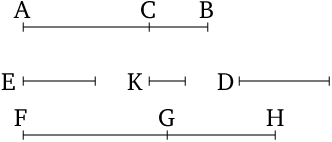Proof: By Euclid
(related to Proposition: Prop. 10.050: Construction of Third Binomial Straight Line)
- Let the two numbers $AC$ and $CB$ be laid down such that their sum $AB$ has to $BC$ the ratio which (some) square number (has) to (some) square number, and does not have to $AC$ the ratio which (some) square number (has) to (some) square number.
- And let some other non-square number $D$ also be laid down, and let it not have to each of $BA$ and $AC$ the ratio which (some) square number (has) to (some) square number.
- And let some rational straight line $E$ be laid down, and let it have been contrived that as $D$ (is) to $AB$, so the (square) on $E$ (is) to the (square) on $FG$ [Prop. 10.6 corr.] .
- Thus, the (square) on $E$ is commensurable with the (square) on on $FG$ [Prop. 10.6].
- And $E$ is a rational (straight line).
- Thus, $FG$ is also a rational (straight line).
- And since $D$ does not have to $AB$ the ratio which (some) square number has to (some) square number, the (square) on $E$ does not have to the (square) on $FG$ the ratio which (some) square number (has) to (some) square number either.
- $E$ is thus incommensurable in length with $FG$ [Prop. 10.9].
- So, again, let it have been contrived that as the number $BA$ (is) to $AC$, so the (square) on $FG$ (is) to the (square) on $GH$ [Prop. 10.6 corr.] .
- Thus, the (square) on $FG$ is commensurable with the (square) on on $GH$ [Prop. 10.6].
- And $FG$ (is) a rational (straight line).
- Thus, $GH$ (is) also a rational (straight line).
- And since $BA$ does not have to $AC$ the ratio which (some) square number (has) to (some) square number, the (square) on $FG$ does not have to the (square) on $HG$ the ratio which (some) square number (has) to (some) square number either.
- Thus, $FG$ is incommensurable in length with $GH$ [Prop. 10.9].
- $FG$ and $GH$ are thus rational (straight lines which are) commensurable in square only.
- Thus, $FH$ is a binomial (straight line) [Prop. 10.36].
- So, I say that (it is) also a third (binomial straight line).

- For since as $D$ is to $AB$, so the (square) on $E$ (is) to the (square) on $FG$, and as $BA$ (is) to $AC$, so the (square) on $FG$ (is) to the (square) on $GH$, thus, via equality, as $D$ (is) to $AC$, so the (square) on $E$ (is) to the (square) on $GH$ [Prop. 5.22].
- And $D$ does not have to $AC$ the ratio which (some) square number (has) to (some) square number.
- Thus, the (square) on $E$ does not have to the (square) on $GH$ the ratio which (some) square number (has) to (some) square number either.
- Thus, $E$ is incommensurable in length with $GH$ [Prop. 10.9].
- And since as $BA$ is to $AC$, so the (square) on $FG$ (is) to the (square) on $GH$, the (square) on $FG$ (is) thus greater than the (square) on $GH$ [Prop. 5.14].
- Therefore, let (the sum of) the (squares) on $GH$ and $K$ be equal to the (square) on $FG$.
- Thus, via convertion, as $AB$ [is] to $BC$, so the (square) on $FG$ (is) to the (square) on $K$ [Prop. 5.19 corr.] 2.
- And $AB$ has to $BC$ the ratio which (some) square number (has) to (some) square number.
- Thus, the (square) on $FG$ also has to the (square) on $K$ the ratio which (some) square number (has) to (some) square number.
- Thus, $FG$ [is] [commensurable in length]bookofproofs$1095 with $K$ [Prop. 10.9].
- Thus, the square on $FG$ is greater than (the square on) $GH$ by the (square) on (some straight line) commensurable (in length) with ($FG$).
- And $FG$ and $GH$ are rational (straight lines which are) commensurable in square only, and neither of them is commensurable in length with $E$.
- Thus, $FH$ is a third binomial (straight line) [Def. 10.7] .
- (Which is) the very thing it was required to show.
∎
Thank you to the contributors under CC BY-SA 4.0! 

- Github:
-

- non-Github:
- @Fitzpatrick
References
Adapted from (subject to copyright, with kind permission)
- Fitzpatrick, Richard: Euclid's "Elements of Geometry"
